Table of Contents
ToggleAverage Cost of Skate Park Lighting
Calculating the cost of operating a skate park lighting system involves considering various factors, including usage and budgeting. The price of each lighting fixture varies based on output quality, which includes lumen values (light intensity) and spectrum quality. Budget constraints or the owner’s aspirations can influence the choice and associated expenses.
Cost for Recreational Skate Parks
The cost of lighting for a recreational skate park generally ranges from $500 to $1,500. This price depends on the size of the park, the number of ramps, wedges, pools, and stairs. For skate parks used exclusively for leisure, this cost is sufficient to ensure adequate lighting.
Cost for Local or Regional Competitions
For skate parks hosting local or regional skateboarding competitions, the cost increases significantly, ranging from $2,000 to $5,000. The investment in lighting for these events needs to accommodate the demands of competition-level visibility and safety, as well as the potential for increased crowds.
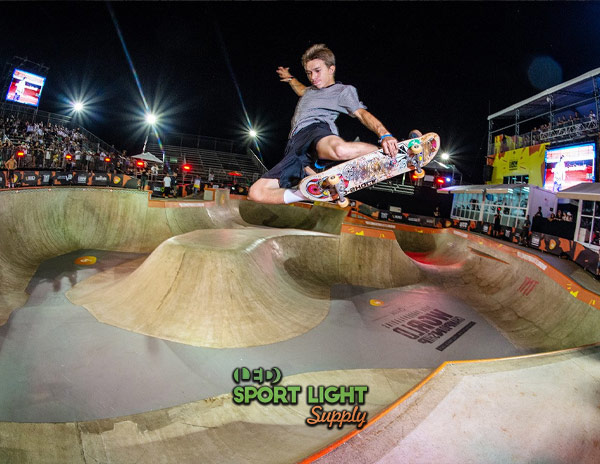
Cost for International Skateboarding Competitions
Hosting international skateboarding competitions requires a higher budget. The cost for setting up lighting for these large-scale events ranges from $10,000 to $50,000. This setup includes lighting for spectators, broadcasters, and professional skateboarders. Additionally, special effect lights may be rented to enhance the event’s atmosphere.
For major events like the Street League Skateboarding, which features numerous professional skateboarders, the lighting must meet high standards of illuminance. This ensures clear visibility for every trick and transition, as well as optimal conditions for broadcasting and streaming. High-quality lighting equipment with a high TLCI rating is often included to meet these demands.
Additional Considerations
Security lighting is essential for the safety of both participants and spectators. Adequate lighting uniformity is crucial to avoid shadows, which ensures that every area of the skate park is well-lit regardless of the crowd size. Events like the Dew Tour or X-Games highlight the need for effective lighting to allow spectators to comfortably view tricks without glare or visual discomfort.
The more efficient the lighting system, the higher the installation and operating costs. For comprehensive coverage and optimal performance, costs can reach up to $50,000.
What Determines the Cost of Skate Park Lights?
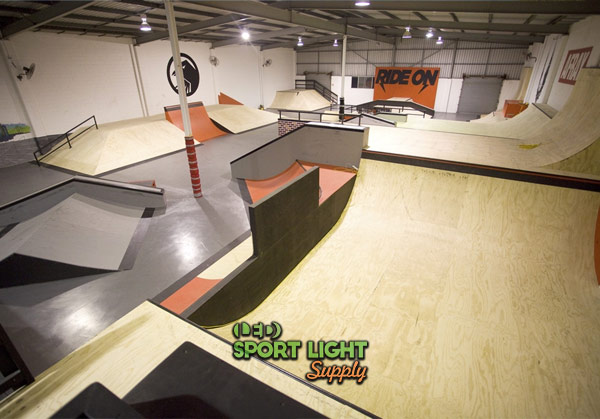
Size of the Skate Park
The size of the skate park significantly impacts the cost of lighting. Larger skate parks require more lumens to achieve the desired lux levels, which is crucial for adequate illumination. The minimum recommended lux level for a skate park is 200, though smaller parks with basic features might require slightly less. However, for any skate park larger than 2,000 square feet, 200 lux is the minimum standard.
A large skate park may include various recreational areas such as picnic tables, viewing areas, and boardwalks. If these areas are adjacent to the park, local regulations may necessitate additional lighting for safety, thereby increasing the overall cost. The more extensive the area, the higher the lighting costs due to the need for additional fixtures and poles.
Light Pole Layout
The layout of light poles plays a crucial role in determining the overall cost of lighting a skate park. The design of the lighting layout involves several considerations that directly impact both the effectiveness of illumination and the financial implications. Two primary factors that influence the lighting layout are the height of the light poles and the number of poles required.
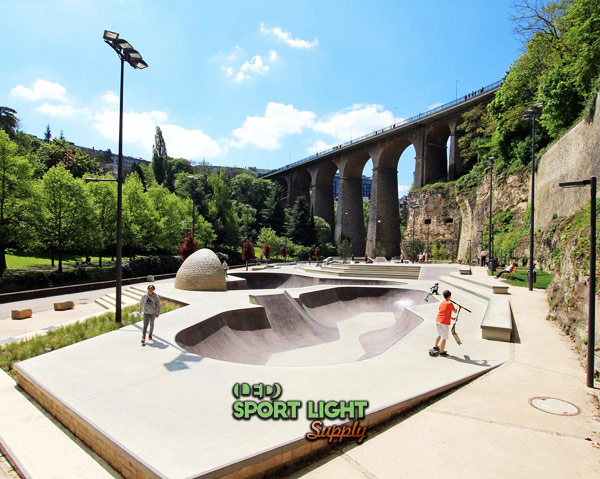
Light Pole Height
The height of light poles is a key factor affecting light distribution and overall cost. Taller poles can cover a larger area but also result in increased light loss. This phenomenon occurs because light spreads out as it travels, causing a reduction in intensity as the distance from the light source increases. As a result, higher poles necessitate more powerful fixtures or additional lights to maintain adequate illumination levels.
Impact on Light Loss
The greater the height of the poles, the more significant the light loss, which means that more fixtures are needed to compensate for the reduced intensity at ground level. This not only increases the initial cost of the lighting system but also leads to higher ongoing energy and maintenance costs. To counteract the increased light loss, you may need to use high-output fixtures or place additional poles, both of which contribute to higher expenses.
Need for Spotlights
If optimal pole positioning is not feasible due to site constraints or design limitations, spotlights might be required. Spotlights are designed to provide focused illumination over a long range and are typically more expensive than standard flood lights. The need for spotlights can further elevate costs, making careful planning and strategic pole placement essential for managing expenses effectively.
Number of Light Poles
The number of light poles required is directly related to their spacing. The distance between poles influences the coverage area and the uniformity of light distribution. Proper spacing is crucial to achieving consistent illumination and avoiding areas of excessive darkness or glare.
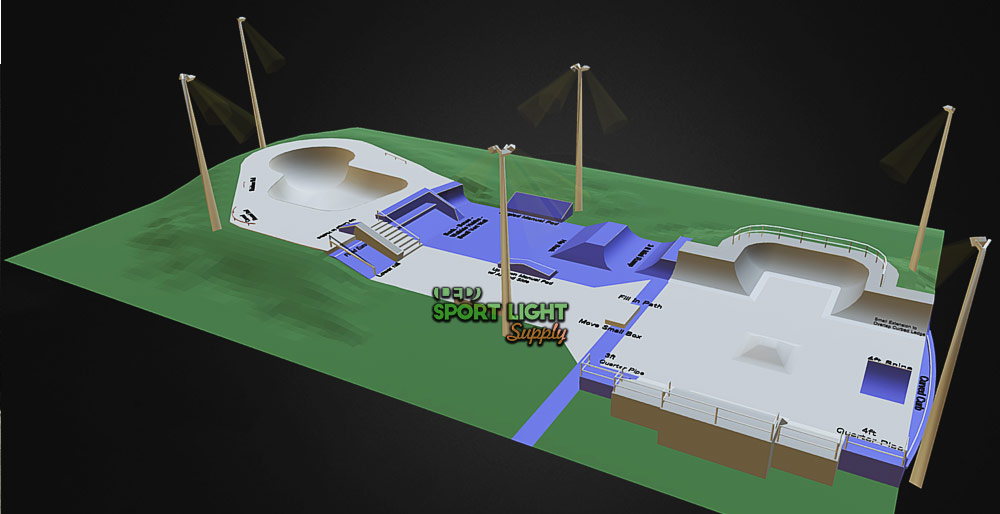
Effect of Spacing on Light Distribution
Wider spacing between poles generally leads to increased light loss and potential gaps in coverage. To ensure uniform illumination across the skate park, it may be necessary to increase the number of poles. This additional installation not only raises the initial cost but also affects ongoing maintenance and energy consumption.
Importance of Effective Planning
Effective planning is essential to balance the number of poles with the desired lighting quality. A well-designed layout optimizes the placement of poles to minimize the need for excess fixtures while ensuring adequate coverage. This approach helps avoid unnecessary costs associated with redundant poles or inadequate lighting, leading to a more efficient and cost-effective solution.
Level of Competitions
The level of competition for which the skate park is designed influences lighting requirements. With skateboarding now included in the Olympics, lighting standards have become more stringent:
Lighting Classes
Different levels of competition require varying lighting standards, classified as follows:
| Lighting Class | Lux Level | Uniformity | CRI/TLCI |
|---|---|---|---|
| Class I | 700-2,000 | 0.7 | >85 Ra / >90 TLCI |
| Class II | 500-800 | 0.7 | >85 Ra / >90 TLCI |
| Class III | 150-250 | 0.4 | >85 Ra / >90 TLCI |
Class I events, such as international competitions, require the highest lux levels and uniformity, while Class III events, such as recreational use, have the lowest requirements.
Shape of Ramps
The design and shape of ramps also affect lighting needs. Ramps can create shadows that must be eliminated to ensure safety. For example, a mega ramp, being taller and more complex, requires specialized lighting to prevent shadows and ensure even illumination. This often involves using spotlights and high masts to achieve optimal lighting distribution.
Ramps with intricate designs may necessitate additional lighting equipment and higher masts, increasing costs. The expense will vary based on the desired level of competition and the associated return on investment.
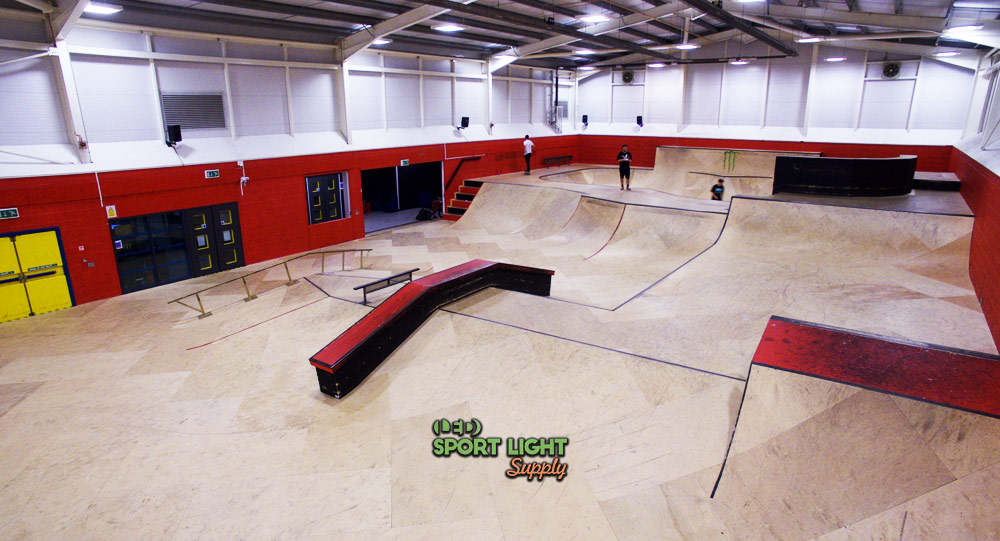
How to Save on Skate Park Lighting Costs
Using LED Lights
Switching to LED lights is one of the most impactful strategies for reducing the costs associated with skate park lighting. LEDs offer several advantages over traditional lighting options like metal halide, HID, and mercury vapor bulbs, leading to significant long-term savings.
Longevity and Maintenance
One of the most compelling benefits of LED lights is their longevity. LED lamps can last up to ten times longer than traditional lighting sources. This extended lifespan means fewer replacements and less frequent maintenance, translating into substantial savings over time. With traditional bulbs, frequent outages and replacements can disrupt the operation of the skate park and incur additional labor and material costs. In contrast, LED lights require far less attention, allowing park operators to focus on other aspects of park management.
Furthermore, the durability of LEDs contributes to their cost-effectiveness. Unlike traditional bulbs, which are prone to breakage and performance degradation, LEDs are more robust and resilient. This durability ensures that the park maintains consistent lighting quality, reducing the likelihood of safety issues and the need for emergency repairs.
Energy Efficiency
Energy efficiency is another significant advantage of LED lights. LEDs consume a fraction of the power required by traditional lighting sources to produce the same amount of illumination. This increased efficiency results in lower energy bills, making LED lights a more economical choice in the long run. By switching to LEDs, skate parks can achieve the same or even superior lighting quality while significantly reducing their electricity consumption.
The lower power consumption of LEDs also contributes to a smaller carbon footprint. For environmentally conscious skate park operators, this reduction in energy use aligns with sustainability goals and helps reduce the overall environmental impact of the park.
Customization and Smart Controls
LED lights provide a high degree of flexibility in terms of color temperature and brightness. This customization capability allows skate park operators to create a more welcoming and visually appealing environment. Whether aiming for a cool, bright light for daytime activities or a warmer, softer light for evening sessions, LEDs can be tailored to meet specific needs.
In addition to color temperature adjustments, LED lights can be integrated with dimmable features and smart lighting control systems. These technologies enable dynamic adjustments based on real-time requirements. For example, lighting levels can be lowered during periods of inactivity or adjusted to highlight specific areas of the park during events. This adaptability not only enhances the user experience but also contributes to further cost savings by optimizing energy usage.
Smart lighting controls can also provide valuable data on energy consumption and lighting performance. This information allows for ongoing optimization and maintenance, ensuring that the lighting system remains as efficient and cost-effective as possible.
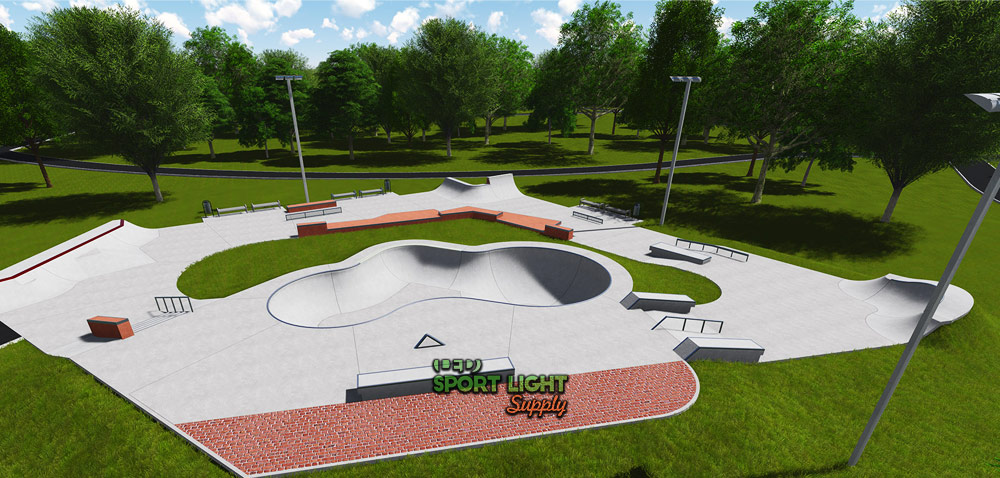
Getting a Lighting Design
Investing in a professional lighting design can substantially impact your skate park’s lighting costs. A well-executed design not only ensures optimal illumination but also helps in avoiding unnecessary expenses. Here’s how professional lighting design can save you money.
Photometric Analysis
A skilled lighting designer conducts a photometric analysis to evaluate the specific lighting needs of the skate park. This process involves measuring the required light levels and determining the best placement for fixtures to achieve uniform illumination. By carefully analyzing the park’s layout, the designer can develop a plan that provides adequate lighting with minimal equipment.
This targeted approach helps prevent the installation of excess lights that would otherwise increase costs without providing additional benefits. The analysis ensures that every area of the park is illuminated effectively, reducing wastage and optimizing the performance of the lighting system. As a result, you avoid overspending on unnecessary fixtures and lower both initial setup costs and long-term operational expenses.
Cost-Effective Solutions
A comprehensive lighting design provides more than just a lighting plan; it offers a cost-effective strategy for managing both installation and operational costs. By maximizing the efficiency of the lighting system, the design helps ensure that you are not paying for more lighting than necessary.
Effective design also contributes to lower ongoing expenses by enhancing the performance and longevity of the lighting setup. With optimal fixture placement and accurate illumination levels, you minimize energy consumption and maintenance needs. This results in reduced electricity bills and fewer repair or replacement costs, making the lighting system more economical in the long run.
Asking for Discounts
Once you have a well-prepared lighting design, leveraging it to negotiate discounts with suppliers can lead to additional savings.
Bulk Purchase Discounts
Many lighting manufacturers and suppliers offer discounts for bulk purchases. By consolidating your lighting needs with one contractor, you can often secure a discount ranging from 5 to 10% on the price of lamps and other equipment. This approach not only reduces the per-unit cost but also simplifies the procurement process, as you deal with a single supplier for all your needs.
Requesting Quotes
To take advantage of potential discounts, start by requesting free quotes from multiple suppliers. Most companies are willing to provide their best offer based on your project specifications. This competitive process allows you to compare prices and terms, ensuring you get the best deal available.
While seeking quotes, ensure you carefully evaluate the quality of the lighting equipment and the reliability of the suppliers. Choose a supplier that offers high-quality products and dependable customer support to avoid future issues.
Evaluating Manufacturers
When negotiating discounts, it is crucial to assess the reputation and service level of the manufacturers or suppliers. Be cautious of extremely low prices from sources that lack a solid track record or are located overseas, as they might pose risks related to product quality and support. Establish a clear understanding of the supplier’s operations and their responsiveness to inquiries before finalizing your decision.
Conclusion
Investing in a professional lighting design and switching to LED lights can significantly reduce skate park lighting costs. By conducting a thorough photometric analysis, you ensure optimal illumination with minimal equipment, avoiding unnecessary expenses. Leveraging bulk purchase discounts and negotiating with reputable suppliers can further enhance savings. Together, these strategies lead to a more cost-effective and efficient lighting solution for your skate park.
